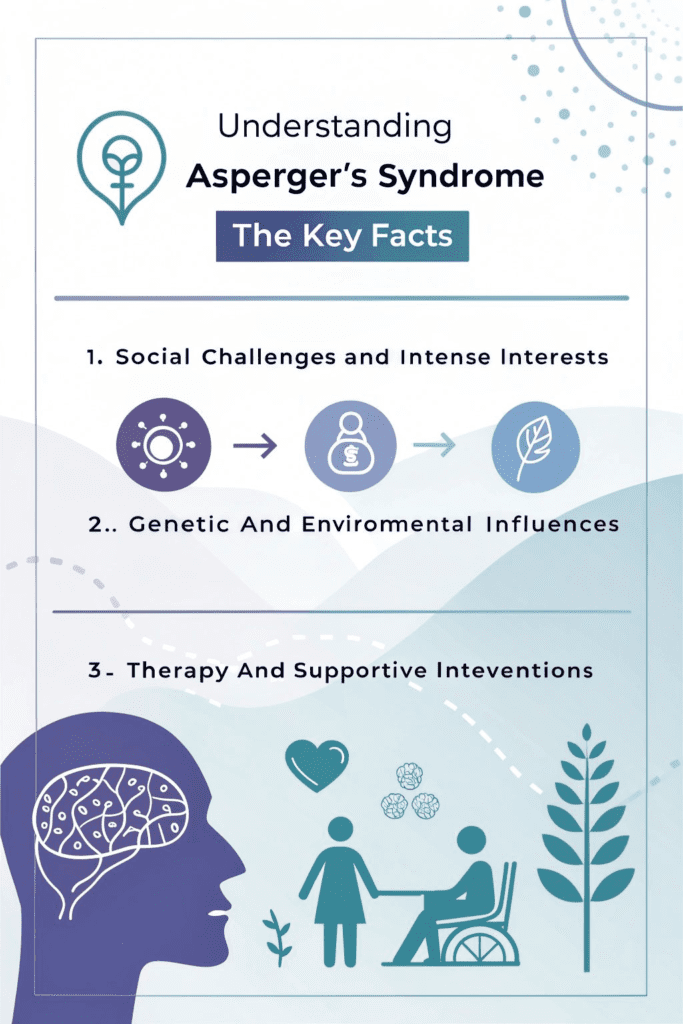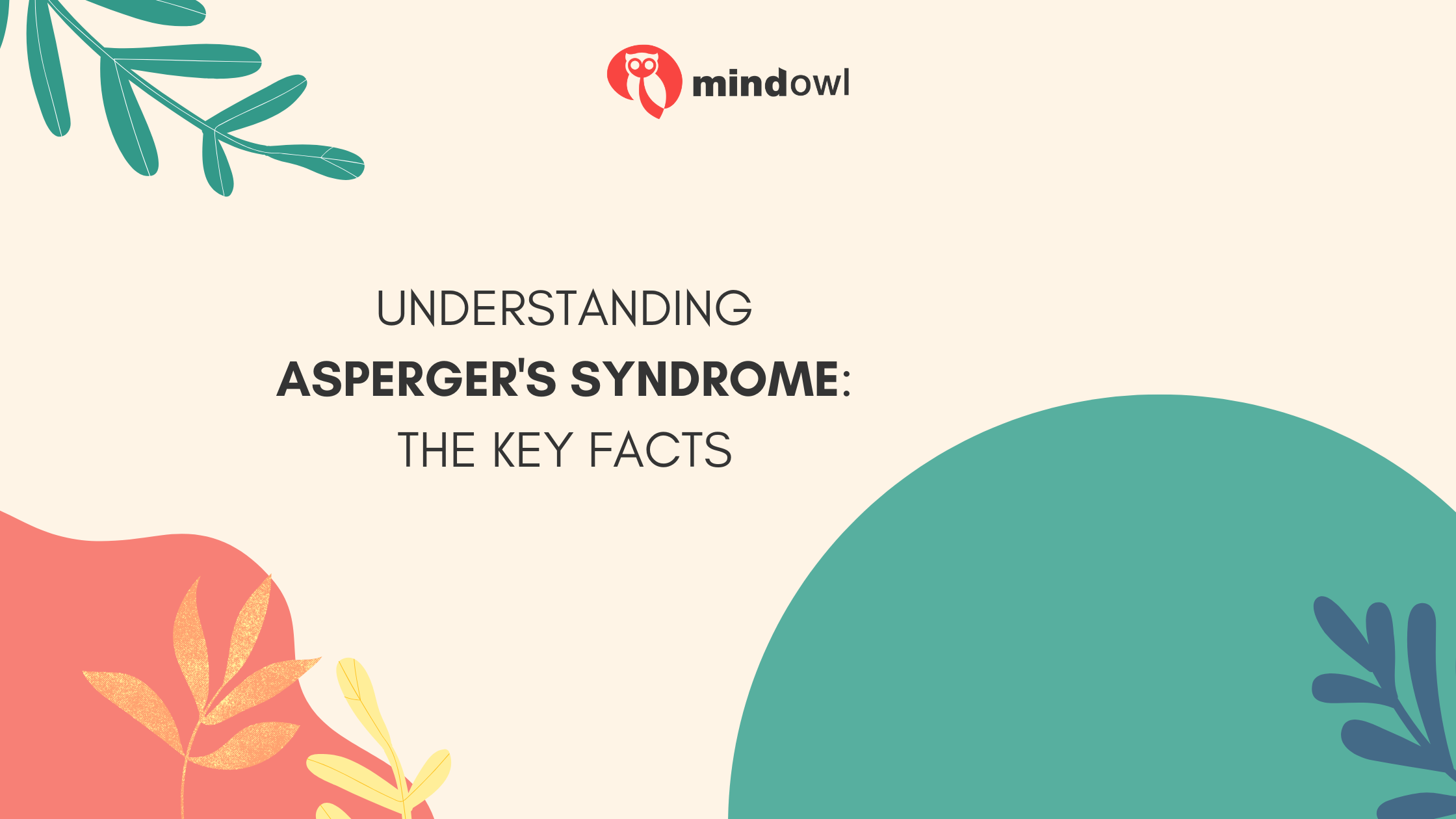Understanding Asperger’s Syndrome can be a complex task for many. This condition impacts the way people connect with others and perceive their environment. This article aims to provide essential information on Asperger’s Syndrome.
Continue reading for further understanding.

Exploring the Characteristics of Asperger’s Syndrome
Asperger’s Syndrome shows through unique social challenges and behaviors. People with this condition may find conversations tough and have specific patterns in how they act or do things repeatedly.
Challenges in Social Interaction
Individuals with Asperger’s syndrome frequently have difficulty establishing eye contact and interpreting social signals. This can leave them feeling out of place in social environments.
Their expressions of emotions may differ from those typically expected, which could contribute to their speech seeming unvaried. At times, they may communicate spontaneously, without contemplating the potential reactions of others.
This candour can be perceived as either invigorating or shocking.
Despite these challenges, these people genuinely desire to forge friendships and become active participants in social groups. However, they may find this difficult due to their distinct social skills.
Regardless of whether it’s a children’s playgroup or a casual get-together, social integration presents a formidable hurdle for them. Their struggles with the subtleties of non-verbal communication exacerbate the complexities of forming relationships with their peers.
Patterns of Restricted and Repetitive Behaviours
People with Asperger’s Syndrome often show patterns of restricted and repetitive behaviours. They might focus intensely on specific topics, like sports stats or kinds of rocks, for a long time.
This strong focus shows their deep interest in certain subjects. These individuals also repeat actions or words more than most people do. For example, they may line up toys in a precise order every time they play.
They usually don’t like changes to their routine and prefer things to stay the same. If something changes, it can really upset them. Repetitive movements or gestures are another sign.
Some might rock back and forth or flap their hands when they’re excited or stressed. Sensory sensitivities are common too. Loud noises or bright lights can be overwhelming for them, leading to coping behaviours that might seem repetitive to others, like covering ears frequently around loud sounds.
Distinct Speech and Language Features
People with Asperger’s Syndrome frequently exhibit distinct traits in their speech and language. They may face difficulties in various language fields, such as pragmatics (applying language in social situations), grammar, semantics (the significance of words), syntax (construction of sentences using words), phonology (the sounds in speech), and morphology (word structures).
This can make it tricky for them to communicate. Some might choose to speak minimally or not at all, whereas others might express themselves extensively yet encounter obstacles in effective communication during social interactions.
Despite these hurdles, many people with Asperger’s Syndrome develop striking verbal skills. They may possess broad vocabularies and demonstrate innovative linguistic usage. Nonetheless, they often find it challenging to apply this talent appropriately in social scenarios owing to difficulties with pragmatic language.
These issues comprise understanding the appropriate manner and timing to input into conversations effectively. Their refined verbal ability can camouflage their challenges with the practical side of communication, underlining the necessity of support and understanding from others.
Sensitivity to Sensory Inputs
Many individuals with Autism Spectrum Disorder (ASD) experience strong reactions to sensory inputs. For instance, about 90% have atypical responses to things they see, hear, or touch.
Sounds may seem louder, and lights brighter than for others. Around 40% of children with ASD find smells and tastes overwhelming or unusual.
Sensory sensitivities can lead to early social withdrawal in children with ASD.
Tactile hypersensitivity, where the sensation of touch is intensified, often impacts how someone with Asperger’s interacts socially. These heightened senses play a critical role in diagnosing ASD.
Understanding these sensitivities helps us support those affected by making their environments more comfortable.
Investigating the Causes of Asperger’s Syndrome
Scientists believe genes play a role in Asperger’s syndrome. Sometimes, kids get traits linked to Asperger’s from their parents’ DNA. This is why some families have more than one person with an autism spectrum disorder.
Research also shows trouble during pregnancy can increase the chances of having a child with this condition. For example, if a mum faces health issues or stress when she’s pregnant, it might affect her baby’s brain growth.
Exposure to certain harmful substances early in pregnancy can also lead to development problems related to Asperger’s syndrome. Studies connect these risks with times even before many mums know they are pregnant, especially in the first eight weeks after conception.
Despite all this research, experts haven’t found one single cause for Asperger’s syndrome yet. They keep looking into how different factors like genetics and environmental conditions work together to influence brain development in people with this form of autism.

Methods for Diagnosing Asperger’s Syndrome
Diagnosing Asperger’s Syndrome involves specific criteria outlined in the Diagnostic and Statistical Manual of Mental Disorders (DSM-5). Health professionals assess a person’s social interactions, communication skills, and behaviour patterns to make an accurate diagnosis.
What criteria are used in the DSM for Asperger Syndrome?
The Diagnostic and Statistical Manual of Mental Disorders (DSM) outlines specific criteria for Asperger Syndrome. Individuals must show at least two signs of impairment in social interaction, such as difficulty with nonverbal communication or maintaining peer relationships.
They also need to exhibit at least one sign of restricted or repetitive behaviour, like intense focus on a particular subject.
These impairments must considerably affect the person’s daily life. Social, occupational, or other important areas must all reflect clinically significant challenges due to these symptoms.
The DSM categorises Asperger Syndrome under Autism Spectrum Disorder but notes that many still use the term “Asperger’s” when referring to those diagnosed with this syndrome.
What are the steps involved in the diagnosis of Asperger Syndrome?
Diagnosing Asperger’s Syndrome involves careful assessment. Trained professionals evaluate various skills and behaviours.
- Medical experts like paediatricians, psychologists, and neurologists gather information. They ask questions about social abilities and communication skills.
- They also assess learning capacities and movement skills. Observations include how someone interacts with others.
- Diagnostic tools play a significant role in this process. Tools include the Asperger Syndrome Diagnostic Scale (ASDS) and Autism Spectrum Screening Questionnaire (ASSQ).
- These instruments help professionals identify specific symptoms of Asperger’s Syndrome accurately. The Childhood Autism Spectrum Test (CAST) is also used.
- Clinicians may administer the Gilliam Asperger’s Disorder Scale (GADS) or the Autism-Spectrum Quotient (AQ). Each tool provides insight into the individual’s condition.
- Specialists analyse the results to determine if an individual meets diagnostic criteria set by the DSM-5 or ICD-11 guideline standards.
- Experts discuss findings with families, explaining any diagnoses reached together clearly.
- Diagnosis delays can hinder treatment outcomes significantly, causing frustration for families seeking assistance.
- It’s important to understand that distinguishing Asperger’s from other forms of autism is still debated among researchers, impacting treatment approaches.
- Professionals aim to provide thorough care while navigating these complex dynamics in autism spectrum disorder assessments.
Why is the term “Asperger Syndrome” still used despite being called Autism Spectrum Disorder?
The term “Asperger Syndrome” still appears in conversations about autism. Many people find it familiar and specific. Historically, experts used this label for autistic individuals who did not have a learning disability.
In 2013, the American Psychiatric Association reclassified Asperger’s as part of Autism Spectrum Disorder (ASD) in the DSM-5. This change removed Asperger syndrome as a separate diagnosis but introduced social pragmatic communication disorder as related.
Despite this shift, many continue to use the term due to its historical significance. People with autism spectrum disorder may feel more comfortable identifying with terms they’ve known for years.
The controversy surrounding Hans Asperger’s association with Nazi policies adds complexity to discussions about his legacy and name recognition within neurodiversity circles.
Strategies for Managing and Supporting Asperger’s Syndrome
Therapeutic interventions play a key role in supporting those with Asperger’s Syndrome. Parents can adopt practical techniques and seek medication when necessary to help manage symptoms effectively.
Therapeutic Interventions
Therapeutic interventions play an essential role in supporting individuals with Asperger’s syndrome. They help improve coping skills and social interactions.
- Cognitive Behavioural Therapy (CBT) helps individuals manage anxiety and obsessive thoughts. This therapy teaches practical strategies to change thinking patterns. Many people find it effective for overcoming daily challenges.
- Occupational Therapy focuses on developing everyday skills. It assists in improving motor skills and supports sensory integration issues. This type of therapy can significantly enhance quality of life.
- Social Skills Training aims to improve communication and relationship-building abilities. Individuals learn to interpret body language, facial expressions, and other social cues effectively. This training fosters confidence in social situations.
- Parent Management Training educates parents on better support techniques for their children. Parents learn how to reinforce positive behaviours at home. This approach strengthens family dynamics.
- Medication may assist in managing symptoms like hyperactivity or anxiety, though no specific drug is approved solely for Asperger’s syndrome. Doctors often prescribe medications based on individual symptoms and needs.
- Dietary approaches have gained attention, with some exploring gluten-free or casein-free diets for potential benefits, yet scientific support remains limited overall.
- Natural supplements such as melatonin can help regulate sleep patterns while omega-3 fatty acids might offer additional health benefits, although research results vary widely.
- A combination of multiple treatment strategies often yields the best outcomes for those with Asperger’s syndrome, addressing various aspects of their development and mental health thoroughly.
Techniques for Coping and Medication Uses
Understanding Asperger’s Syndrome requires effective coping strategies and appropriate medication use. Individuals with this syndrome may benefit from a combination of therapies and medical support tailored to their unique needs.
- Cognitive behavioural therapy (CBT) offers practical tools for managing anxiety and improving social skills. It helps individuals identify unhelpful thought patterns and develop healthier responses.
- Medication can assist in managing symptoms like anxiety or depression associated with Asperger’s Syndrome. Medications such as SSRIs may help but carry potential side effects like behavioural activation or sleep disturbances.
- Stimulants can treat attention deficit hyperactivity disorder (ADHD) symptoms often seen alongside Asperger’s. However, it’s crucial to monitor for increased impulsivity or other unwanted effects.
- Antipsychotics might be prescribed for severe behavioural symptoms, though they may lead to weight gain and metabolic issues. Physicians must weigh the benefits against these potential risks when considering this option.
- Developing routine coping techniques is key for daily life management. Techniques include mindfulness practices, deep breathing exercises, and structured schedules that promote stability.
- Support groups provide a platform for individuals to share experiences and learn from each other. These groups foster a sense of community among people with Asperger’s Syndrome and their families.
- Parents should engage in active parenting strategies that encourage independence while providing necessary support. This balance promotes confidence in children when navigating social situations.
- Occupational therapy can enhance sensory integration skills, addressing sensitivity to sensory inputs commonly associated with the syndrome. This therapy aids in adapting environments to reduce discomfort from overwhelming stimuli.
- Education about Asperger’s helps peers understand the behaviours related to the syndrome better, promoting empathy within social interactions among teens with Asperger’s Syndrome.
- Keeping an open dialogue between individuals diagnosed with Asperger’s Syndrome and healthcare providers fosters trust and improves treatment outcomes over time.
Identifying Common Comorbidities Associated with Asperger’s Syndrome
Asperger’s Syndrome often appears alongside other disorders. Individuals face numerous challenges related to comorbidities. Anxiety and major depressive disorder affect around 65% of people with Asperger’s.
This overlap can heighten feelings of stress and sadness, making daily life even tougher. Research shows that up to 80% of those diagnosed may have Tourette syndrome as well. The repetitive behaviours associated with both conditions can complicate treatment plans.
Research indicates that about 26% of young adults meeting criteria for Asperger’s also qualify for schizoid personality disorder. This dual diagnosis can impact social relationships and emotional well-being significantly.
The rates of suicidal ideation in individuals with Asperger’s are alarmingly high—66% report such thoughts, which is nine times greater than the general population rate. Understanding these common comorbidities aids caregivers in better supporting autistic individuals throughout their lives.
Conclusion
Understanding Asperger’s Syndrome helps us support individuals with this developmental disorder. It affects emotional and social skills, leading to unique challenges. Symptoms often appear in early childhood but can continue into adulthood.
Treatment options like cognitive behavioural therapy and speech-language therapy offer significant benefits. With the right support, many individuals lead fulfilling lives and succeed academically and professionally.
MindOwl Founder – My own struggles in life have led me to this path of understanding the human condition. I graduated with a bachelor’s degree in philosophy before completing a master’s degree in psychology at Regent’s University London. I then completed a postgraduate diploma in philosophical counselling before being trained in ACT (Acceptance and commitment therapy).
I’ve spent the last eight years studying the encounter of meditative practices with modern psychology.

